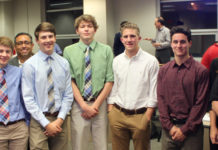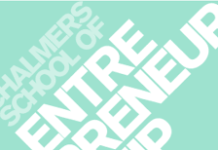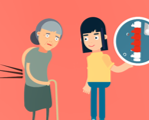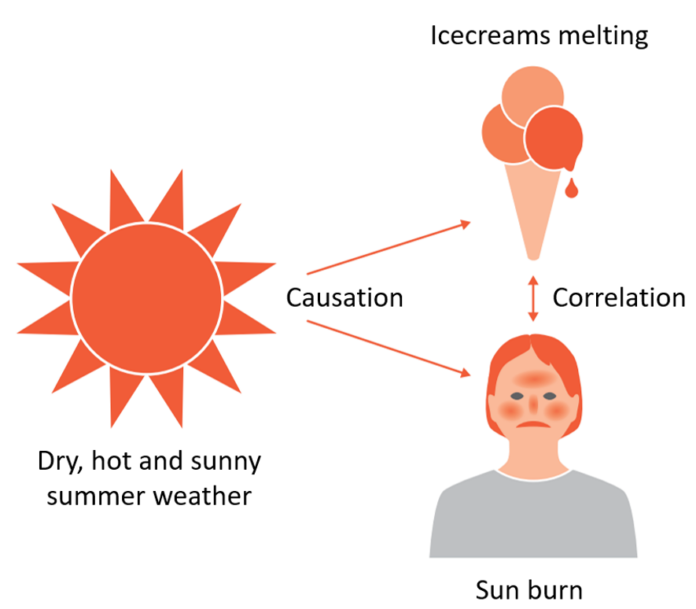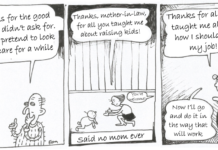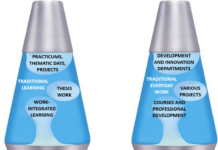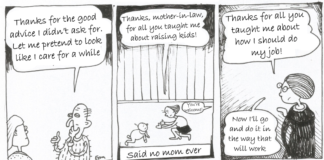The first six parts of this review take us on a journey through the wonderful and confusing world of philosophy. More specifically, the world of philosophy of science. It addresses questions such as what can be considered real, knowable and scientific. Philosophy never provides clear-cut answers, but instead offers different ways of thinking and perspectives that then influence everything you do in practice.
From clinical research we bring the idea of learning by helping others. Pragmatism contributes with its focus on what works in different specific situations, rather than trying to look for universal truths. Critical realism helps us with different ways of thinking to explore weak patterns at a detailed level in social contexts, especially when it comes to trying to find connections between causes and effects. Literature on action learning provides us with models and ideas on how to learn by combining theory and practice. Abduction is a complicated word for something that may seem natural to many, namely to try to move back and forth between theory and practice in our exploration. We conclude our review of the six theoretical parts by taking an emotional perspective on everything we do.
Clinical research – learning by creating value for others
Clinical research is about combining research with helping others. A clinical situation is basically a situation where there is a client who is receiving professional and personalised help from a practitioner.[1] The concept of clinical research originally comes from the medical field, where around 80 percent of all research is clinical.[2] However, clinical situations can be found in all areas of society. Some examples of clinical professionals include counsellors, social workers, consultants, lawyers, managers, customer service operators, tourist guides and, of course, teachers.[3]
A clinical study differs from traditional research in that it consciously abandons the ambition to simply observe, to not interfere with the process being studied. Instead, the researcher’s attempt to change a situation for the better is the main research strategy. Schein (1993, p. 703) refers to the famous sociologist Kurt Lewin (1947) when he writes:
One cannot understand a human system without trying to change it. It is in the attempt to change the system that some of the most important characteristics of the system reveal themselves, phenomena that even the most talented ethnographer would not discover unless he or she happened to be present when someone else was trying to produce some change.
Clinical research is different from both ethnographic research (observational studies in the field) and action research (researchers participating in the social contexts they study). The clinical researcher enters the situation not primarily to collect data, but to help another human being. This means that clinical researchers, unlike most other researchers, are paid for the help they provide, not for the research they conduct. The process of helping is therefore always prioritised over the process of research.
A very special relationship is then established between the clinician and the client. The client opens up and offers their innermost thoughts in a completely different way than in other types of research. The clinical researcher has the opportunity to ask more personal questions and also receives more honest and sincere answers. This is good news for teachers doing research. We can expect that when teachers and peer learning leaders themselves act as clinical researchers, they will have a very different, and probably more accurate, picture of what works for teachers and their students, and why. If an outside researcher from a university were to ask the same questions or test the same ideas about what can help teachers and students, the answers would probably be different, more superficial and less honest.
Despite the benefits of clinical research, only about one thousandth[4] of today’s educational research is clinical. Researcher Ingrid Carlgren (2010, p. 304) describes this as the missing link in education and calls for change:
It is important that educational sciences develop their own ‘clinical’ research approaches, which are sensitive to the specific nature of educational activities.
Designed action sampling is precisely a clinical research approach adapted to the unique conditions of education. The helping tasks are designed or selected and implemented by the teachers themselves. Teachers test new ideas on their own students, with whom they have a unique and intimate relationship. The research process is also led by teachers, educational managers and principlals in the educational institutions, who in turn collaborate with colleagues in the development of teaching.
Pragmatism – What works for whom, when and how?
Pragmatism[5] is a philosophical orientation that emerged in the United States at the end of the 19th century. Key figures were William James, Charles Sanders Peirce and John Dewey. Being pragmatic means being down-to-earth, realistic and functional, and has some affinity with philosophical pragmatism.
Translated into educational research, pragmatism is about abandoning the question “What works?”. and instead asking “What works for whom, when, how and why?”. Pragmatism does away with the idea that there is a universal truth and that we should now try to find it. Instead, pragmatism balances somewhere in the middle between objectivism and subjectivism, see Figure 1.1 in Chapter 1. Even if there are no universal truths, pragmatism suggests that there are more or less intelligent ways of dealing with an ever-changing and often problematic reality. It is also possible to create a shared world between individuals, but only if we act together. So simply talking to each other and exchanging ideas, as collegial learning often manifests itself in educational institutions, is not enough.
Pragmatism emerged as a response to a perceived crisis of rationality in society, an over-reliance on cognitive, theoretical, mathematical and mechanistic truths and a corresponding devaluation of practical actions, human values, perceived emotions and humanism. Pragmatism instead advocated seeing knowledge and action (or theory and practice) as united, that one must always take action through experimentation to produce knowledge. Therefore, according to pragmatism, engaging in educational research without a strong link to educational practice is not very meaningful.
Taking pragmatism seriously will force us to re-evaluate what educational research really is. The search for universal recipes and rules then becomes a futile attempt to separate theory from practice and is unlikely to lead to better education. Instead, what pragmatism requires is that teachers take an active role in making thoughtful choices between different possible actions and then trying out actions they believe in in their own teaching to see what works for them. Instead of an isolated group of researchers conducting experiments, according to pragmatism all teachers must participate in conducting experiments, and experimentation must become an integral part of their daily lives, as life in general is experimental and changeable according to pragmatism. Experimentation is required to gain knowledge, but will never lead to the discovery of the Truth with a capital T.
The research focus in education thus needs to shift from outsiders objectively trying to describe a reality they observe, to teachers themselves studying the relationships between their own actions and the effects on their own students.[6] In other words, research in education rather than research about education. According to Biesta and Burbules (2003, p. 97), what is needed are “instruments for our everyday action”, tools that enable and facilitate teachers to act in such ways. Designed action sampling is intended to be just such a tool, a method for how teachers themselves can link theoretical knowledge, practical action and reflection in their own everyday lives.
Pragmatism also gives a sense of what designed action sampling will not be able to deliver. What we call tasks in this book will probably not be able to develop over time into general “rules” or “recipes” for how teachers should do in order to succeed in their teaching. What we can hope for, however, is that teachers themselves will be able to exchange tasks among themselves. This will enable them to build up their own locally produced evidence of what works for them, in which situations and why, more quickly and in a more co-ordinated way. We can also hope that designed action sampling makes pragmatic learning processes for teachers more accessible, manageable and meaningful. Or, in short, easier.
Critical realism – looking for cause-and-effect patterns at a detailed level.
The philosophy of science approach of critical realism emerged in the 1970s as a counter-reaction to various attempts to either confound or excessively separate natural science and social science research.[7] Applying natural science methods in social science research is common[8] , but it is also associated with a high risk of false conclusions and seriously misleading reasoning.
The regularities often seen in the natural sciences are rarer in the social sciences. This is partly due to the unpredictability of humans as objects of study. They go their own way, both as individuals and collectively. Unlike atoms and elements, humans have a consciousness and thus their own free will. They often decide not to act regularly or rationally[9] , which makes it difficult for researchers looking for patterns. Moreover, social systems are open and indeterminate, in the sense that one can rarely isolate single events experimentally. What happens depends on situations, relationships, history, circumstances and many other factors. In social contexts, everything is interconnected and affects events in unpredictable ways. As such, researchers can rarely find universal rules that predict what will work. Educational science is a particularly difficult case of this type of scientific methodological challenge.
Critical realism as a philosophy of science was founded by British philosopher Roy Bhaskar as an attempt to overcome this methodological challenge by building a more appropriate philosophy of science platform for researchers. Bhaskar’s ideas have been most widely disseminated in social science research. This is also where the challenges of the traditional scientific toolbox have been greatest.
As is customary in philosophy, Bhaskar’s discussions revolve around eternal questions such as “What is real?” (ontology) and “What is knowledge?” (epistemology). However, we will not delve into such philosophical questions here, although they are important and interesting. Instead, we go directly to the aspect of critical realism that is most relevant here.
Many proponents of critical realism recommend that researchers look for causal mechanisms on a micro-level. Three difficult terms in a row, so let’s go through them one by one. Causality is a fancy word for discussing how cause and effect are actually related. Mechanism refers to a phenomenon, occurrence or relationship that is responsible for producing effects of interest.[10] Micro-level research means studying at the detailed level of everyday life. The focus is on the behaviours of individuals or groups, the causes of these behaviours and the subsequent consequences at a more general level, also known as the macro-level.
The idea of studying causal mechanisms at a micro-level is applicable in both natural and social sciences. A mechanism can be physical, chemical, biological, psychological or social.[11] The search for micro-level mechanisms has given critical realism its name. Unlike, for example, postmodernism, it does not deny the existence of a reality out there. Instead, we are encouraged to be critical of the first impressions we may have when studying social phenomena at the overall macro level. Instead, we need to ‘critically’ drill down to the micro-level in search of ‘real’ causal mechanisms – hence the name ‘critical realism’.
We will now try to illustrate critical realism in education. A traditional scientific approach to studying causality in education is to consider the classroom as a black box that is impossible or uninteresting to look into. Researchers then do not try to understand what happens inside the black box, but instead measure before and after a particular educational intervention.[12] Often they do not even bother to measure before, but only after. One example is the OECD’s PISA study, which attempts to measure how different countries’ school systems work by measuring “ready-made” 15-year-olds.[13] Using advanced statistical calculation methods and comparisons of various kinds, mainly various correlation calculations, they then try to say something about whether what happened in the black box (primary school) has had the intended effect.
However, according to critical realism, correlation studies in social contexts are rarely a particularly meaningful scientific method. Fundamental differences between correlation and causality are also often ignored. See an example of this difference in Figure 5.1. Another example of misunderstood causality is to assume that the rooster causes the sunrise because it always crows just before the sun rises.
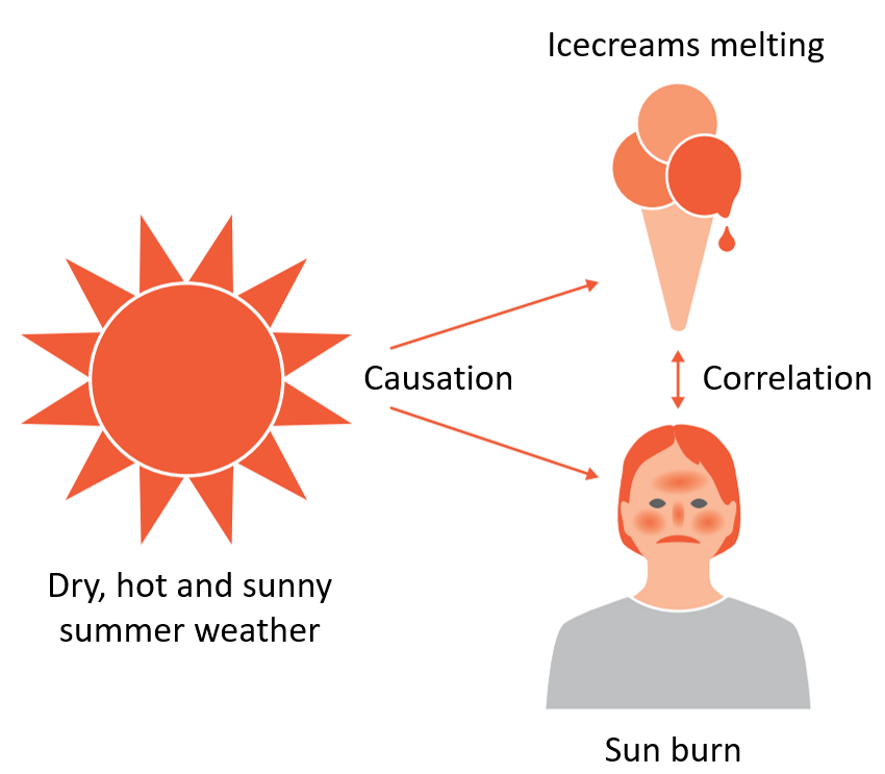
Figure 5.1 The difference between causality and correlation. When the sun makes ice cream melt and people get sunburned, we have causality. For the summer period, a researcher can measure a statistical correlation between the number of melted ice creams and the number of sunburned people. But despite such mathematical correlation, it is not the ice cream that makes people sunburnt, or vice versa. Instead, it is a case of correlation without causality.
According to critical realism, what is needed instead is to open the black box and study the causal mechanisms that affect people at the micro level, such as what happens in the classroom. It is precisely this kind of black box science that designed action sampling is all about. Instead of studying the final result of education in isolation via tests or grades, we study how a certain task performed by a teacher (a certain cause) affects the individuals in the classroom (different effects). Then we can also go further in our causal understanding of when, how and why different effects occur. This can be compared to a macro-level correlation study, which cannot say anything about why different effects occur, only that they occur with some regularity. Methodological researchers Hedström and Ylikoski (2010, p. 51) explain:
[The] mechanism has a structure.When a mechanism-based explanation opens the black box, it discloses this structure. It turns the black box into a transparent box and makes visible how the participating entities and their properties, activities, and relations produce the effect of interest.
Figure 5.2 illustrates how designed action sampling is about using tasks to teachers (causes), and tags that teachers then select (effects), to explore what happens at the micro level in the classroom. The number of tags selected on a given task then tells us something about causality, based on how teachers perceived it. Researchers can then explore further by analysing teachers’ written reflections after each completed assignment. The aim is to look for weak patterns, causal mechanisms at the micro level, which could never have been observed in a study at a macro level. With many teachers’ deep reflections, the peer learning leaders can hopefully also say something about the mechanisms behind the observed micro-level effects – when, how and why they occur, or do not occur. Students can also be involved and participate with their written reflections and tags in the research.
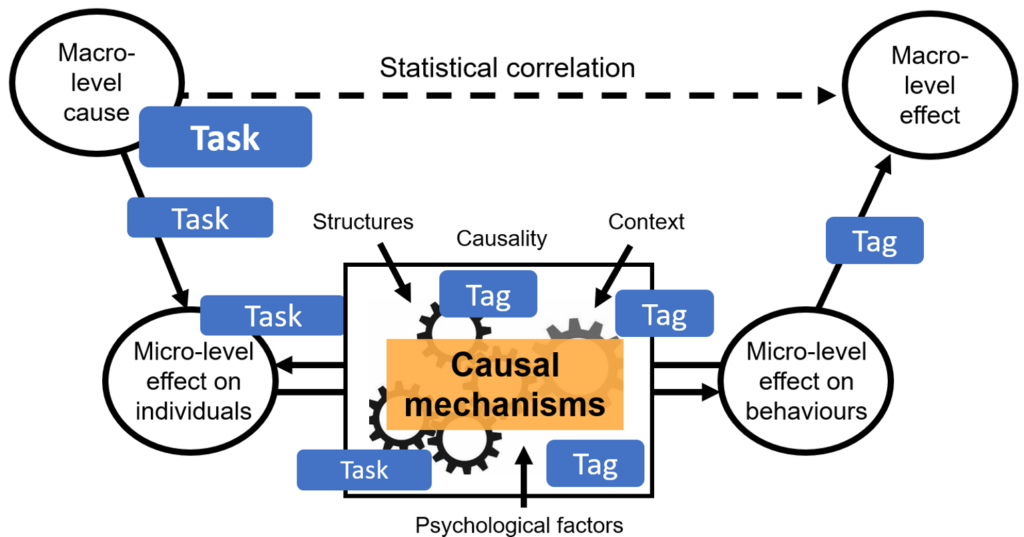
Figure 5.2 Designed action sampling is about trying to explore cause and effect patterns in detail in the classroom or lecture hall. This is in line with the philosophy of science perspective of critical realism. The rectangle is meant to represent the classroom / lecture hall or, in critical realism terms, the ‘black box’. The figure is inspired by an illustration by Ylikoski (2019).
Action-based collective learning – many people probing at the same time
Research is fundamentally about learning new things and thus trying to expand the boundaries of human knowledge – creating new knowledge. This means that you cannot rely solely on traditional learning by reading a book or listening to a lecture. What you want to learn is not yet written down or packaged by someone else. Something more is required, namely learning-by-doing.
Action-based learning is a strong educational tradition, with roots going back many hundreds of years. Important contributions have been made by people like Comenius (1592-1670), Rousseau (1712-1778), Pestalozzi (1746-1827), Dewey (1859-1952), Montessori (1870-1952), Freinet (1896-1966) and Kolb (1939-). Although there is no precise definition of action-based learning that everyone agrees on[14] , many agree that it involves active and practical learning inside or outside the classroom or lecture hall. Like the philosophical discipline of pragmatism, many action learning researchers reject the idea that theory and practice can be separated from each other.[15] Thus, it is not a question of moving from theory-focused learning to practice-focused learning. Instead, the two perspectives need to be brought together.
A model for combining theory and practice was proposed by David Kolb (1984). It is known as Kolb’s learning cycle and has through its simplicity been widely disseminated and applied around the world. Figure 5.3 shows how Kolb’s learning cycle can be used for designed action sampling. In the figure, Kolb’s rather complex concepts (abstract generalisation, active experimentation, concrete experience, reflective observation) are replaced by more concise terms (plan, act, feel, reflect).

Figure 5.3 Kolb’s learning cycle for action-based learning applied to designed action sampling.
With the help of Kolb’s learning cycle, we ensure that a value-creating mission for teachers goes all the way round the learning cycle, so that we get both theory and practice in an integrated way. Reflection is also based on concrete action, which should preferably cause emotion. This deepens learning and new insights become clearer.
Designed action sampling also goes one step further. When many teachers go all the way through the Kolb learning cycle, simultaneously and in similar ways, and then share insights with each other in a structured way, action-based learning becomes even more powerful. After everyone has taken action and reflected individually, they come back together for a collective analysis. Such a meeting begins with an anonymised presentation of the main features of everyone’s reflections. The subsequent collegial discussion then becomes on a higher and more interesting level than if no one had worked through the entire learning cycle with their students in the classroom beforehand. This approach is referred to in this book as action-based collective learning, and is practically illustrated in Example 2.
Example 2: Leadership in the primary school classroom
A primary school wanted to develop the classroom leadership of its forty teachers through designed action sampling. Based on leadership actions designed by an expert in the field, each teacher in the school carried out a new action-oriented task in the classroom every week for two months. The tasks involved greeting and addressing students in new ways, trying new movements and gestures in their body language, preparing lessons a little differently, and starting and ending lessons extra clearly.
At a workplace meeting, it was initially discussed what effects they wanted to achieve from the initiative. This resulted in tags for intended student effects, such as “More students care about their results”, “More students help each other” and “More students have greater focus”. Tags for teacher effects were also designed, such as “I become more confident in my leadership” and “My student relationships improve”.
Teachers tested each task practically in their classrooms and then documented the outcome in writing. The head teacher led the work and had set aside a time each week to provide written feedback on the teachers’ reflections. The expert also provided written feedback.
In meetings with staff, the progress was discussed on an ongoing basis. Different opportunities and challenges were raised based on the teachers’ reflections after tried and tested actions. Statistics showed common effects based on the tags and the average emotional state for each task. Staff participated in dialogue forums about challenges in the work, such as why some assignments did not go so well or how student assistants could participate in the work.
The intervention had the greatest impact among teachers who needed to strengthen their leadership in the classroom, giving them new tools. Principals were able to celebrate successes with individual teachers who shared wise thoughts and magical moments. Teachers felt more recognised by their manager. The principal’s eyes were also opened and the respect for employees who were otherwise less visible was strengthened. The analysis provided an overview that was easy to share with others, which was also done with other school units by the principal.
Abduction – continuous movement between theory and practice
Designed action sampling is about repeatedly moving back and forth between a theoretical ideal and a practical reality, thus allowing understanding to emerge. In scientific language, this is called working with abduction. This is illustrated by an iterative, or circular, movement in Figure 5.4. The idea of abduction comes from one of the founders of pragmatism, Charles Sanders Peirce, and involves the creative and intuitive formulation of new explanations.[16] In 1903, Peirce explained abduction as follows in a lecture at Harvard University (1998, pp. 216-217):
Abduction is the process of forming an explanatory hypothesis. It is the only logical operation which introduces any new idea; for induction does nothing but determine a value and deduction merely evolves the necessary consequences of a pure hypothesis. […] if we are ever to learn anything or to understand phenomena at all, it must be by abduction that this is to be brought about. […] every single item of scientific theory which stands established today has been due to abduction.

Figure 5.4 Abductive approach.
Despite Peirce’s powerful words over a century ago, abduction is today far from being the most established scientific approach. Instead, the most common approach is deduction, which means moving from left to right in Figure 5.4. Based on a theory, a hypothesis is formulated, which is then tested in reality through an experiment. The research work is then completed and the results of the experiment are written up in a research article published in a scientific journal. A longer term for this way of working is the hypothetico-deductive method.
Another common research strategy is induction, which involves moving from right to left in Figure 5.4. Based on an observation of reality, a theory is established. A classic example is to observe many swans, and when all the swans you see are white, after some time you theorise that swans are white. However, there are actually black swans, so induction has its limitations as a research strategy.[17]
To summarise, abduction is an approach that involves repeatedly moving between theory and practice and creatively considering what might be the case. This is compared to induction, which states what is, and deduction, which attempts to prove what must be. As there are few universal truths in education, abduction is therefore likely to be better suited to educational institutions than both induction and deduction.
The work process of designed action sampling thus has no end. The circular movement between theory and practice needs to be ongoing, because we will unfortunately never arrive at a final answer to what works in education. However, teachers can reach ever greater heights of insight and learning about which theoretical ideas that work practically for them in different teaching situations. In this way, they also develop and clarify their own personal theory base.[18]
Emotions in focus – doing and measuring things that are emotional
Being emotional. What do you think about it? Good or bad? In our rational, theory-loving, masculine and technocratic society, emotionality is something we often see as negative and try to eliminate from various situations, especially in science. Scientific methods are often designed to disconnect us from our underlying emotions, as these risk leading us astray when we think too quickly through various kinds of ‘bias’ – emotional fallacies.[19] Thus, science often helps us to think a little slower by suppressing emotions.
But emotions are deeply embedded in all forms of learning, including scientific learning.[20] Where there are strong emotions, we often find powerful learning, and where there are no emotions, there is often little deep learning. Therefore, it would be a serious mistake to try to eliminate emotions from our learning, not only in science but in all forms of learning.
One researcher who has explored the role of emotions in learning is John Heron (1992). He has created a model of learning that shows emotion as the basis for all learning, see Figure 5.5. Heron’s model is well in line with one of the most basic psychological postulates – that human existence consists of three parts: action, thought and emotion.[21] The three parts are called the three basic faculties of mind and serve as a constant reminder that if we focus on just one of them, the absence of the other two will eventually cause us growing problems. In education we often focus excessively on students’ cognitive thoughts and conceptual learning and fail to focus sufficiently on students’ actions and emotions. This common mistake is serious enough in itself but should not be repeated when it comes to teacher learning.

Figure 5.5 Heron’s multimodal model of four forms of learning shows how practical, conceptual and imaginary/intuitive learning are all based on emotion. The figure also links Heron’s model to the three basic elements of human existence – actions, thoughts and feelings. The figure is based on a version of Heron’s model published by Postle (1993).
In order to maintain a good balance between emotion, thought and action, designed action sampling should be largely based not only on value-creating actions, as mentioned above. The role of emotions in learning should also be explicitly recognised. When designing value-creating tasks for teachers, great care should therefore be taken to create tasks that lead to strong emotional experiences for the teachers, and preferably also for their students. This maximises the potential for teacher (and student) learning and deep insights.
When it comes to the risks of emotionality in science, such as thinking too fast, a structured approach to written reflection can be seen as a way of slowing down the pace of participants’ thinking. Mandatory written reflection forces people to stop, think more deeply and document their innermost thoughts and emotions. It can thus be seen as a different way of getting participants to think more slowly than by eliminating or suppressing emotions.
[1] According to Schein (1993).
[2] According to Carlgren (2010).
[3] These examples are taken from an exciting book on helping as a social phenomenon, written by Schein (2010). This entire section is drawn primarily from Schein’s work on clinical action research. See also Coghlan (2009).
[4] According to Carlgren (2010).
[5] Much of this section on pragmatism and educational research draws on insights from a book by Biesta and Burbules (2003). (2003).
[6] See Biesta and Burbules (2003, s. 110).
[7] For a well-articulated description of critical realism in Swedish, see Hylmö (2007). See also the thesis by Seldén (2005) and a book by Danermark et al. (1997).
[8] One example is the neoclassical economic theory, which is based on physical principles and mathematical models, see Mirowski et al. (1991).
[9] The scientist Herbert Simon was awarded the Nobel Prize for his research on human bounded rationality, see e.g. Simon (1955, 2000).
[10] For a more detailed description of what a mechanism is, see Elster (1989).
[11] For an overview in Swedish of mechanisms at different levels, see Brandén (2016).
[12] Randomised control trials are a common way of doing research like this in schools, read more about the limitations of such a research methodology in schools in Reeves (2011).
[13] For a methodological critique of the PISA study, see Berliner (2018).
[14] For a detailed review of action-based learning, see Roberts (2012).
[15] A good review of this perspective has been done by Hägg and Kurczewska (2016).
[16] Read more about creative abduction in Danermark et al. (1997).
[17] An alternative research strategy proposed by Karl Popper was to try to falsify a hypothesis. Instead of looking for more and more white swans, falsification is about trying to find a single black swan. Then you have falsified the theory that swans are white. Read more about falsification in a book by Persson (2014).
[18] An important part of being a reflective practitioner is to clarify for oneself and thereby reduce the difference between the theories one says one builds one’s practice on (espoused theories) and the theories one actually applies in one’s practice (theories-in-use). Researchers Chris Argyris and Donald Schön have written extensively about this. See e.g. Argyris and Schön (1974).
[19] A well-known review of the various risks of bias is written by Kahneman (2012).
[20] Much has been written about the role of emotions in learning. See for example Boekaerts (2010), Postle (1993) and Dirkx (2001). Of particular interest is Jarvis (2006) theory of learning that takes the role of emotions fully into account.
[21] Read more about this fundamental psychological basis in Hilgard (1980).
